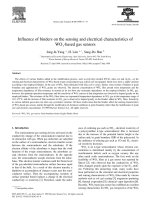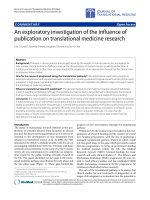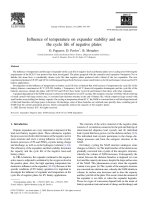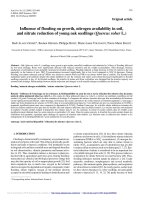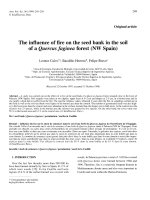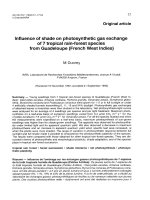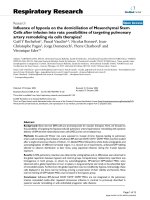Influence of additives on ethylcellulose coatings
Bạn đang xem bản rút gọn của tài liệu. Xem và tải ngay bản đầy đủ của tài liệu tại đây (4.98 MB, 228 trang )
INFLUENCE OF ADDITIVES ON ETHYLCELLULOSE
COATINGS
ONG KANG TENG
(B.Sc. (Pharm.)(Hons.), NUS)
A THESIS SUBMITTED
FOR THE DEGREE OF DOCTOR OF PHILOSOPHY
DEPARTMENT OF PHARMACY
NATIONAL UNIVERSITY OF SINGAPORE
2006
i
ACKNOWLEDGEMENTS
With great gratitude, I wish to thank my respectful supervisors, Associate
Professor Paul Heng Wan Sia and Associate Professor Chan Lai Wah for devoting
much time and effort in supervising and guiding me in my higher degree pursue. They
have given me an education that is worth a lifetime.
I could not have carried out my study without the generous financial supports
from the National University of Singapore and the use of research facilities in the
Department of Pharmacy and GEA-NUS Pharmaceutical Processing Research
Laboratory. I wish to thank the laboratory officers in the Department of Pharmacy,
especially Teresa and Mei Yin, who have never failed to render me their technical
assistance whenever needed. My heartfelt thanks go to all my friends and colleagues
in the Department of Pharmacy and GEA-NUS, especially Celine, Tin Wui, Chit
Chiat, Liang Theng, Sze Nam, Gu Li, Wai See and Qiyun. They have not only shared
with me their valuable experiences but also provided me with their friendship.
My parents and siblings have showered me with much love and supports
which kept me going, especially through difficult times. This journey has been
blessed with many prayerful and spiritual supports of saints both at home and aboard,
for whom I thank God for. All thanks and glory be to God the Father and Lord Jesus
Christ, to whom I owe all things.
Kang Teng
Jan 2006
TABLE OF CONTENTS
ii
CONTENTS
ACKNOWLEDGEMENTS i
CONTENTS ii
SUMMARY vii
List of Tables xii
List of Figures xiv
I. INTRODUCTION 1
A. Film coating 1
1. Reasons for coating 1
2. Film coating polymers 1
3. Organic versus aqueous coating systems 4
4. Aqueous coating systems 5
a. Latex and pseudolatex 5
i. Emulsion polymerization 5
ii. Emulsion - solvent evaporation 5
iii. Phase inversion 6
iv. Solvent change 6
b. Suspension 7
B. Mechanism of film formation 7
C. Substrates for film coating 9
D. Drug release mechanisms of coated pellets 10
1. Diffusion - controlled systems 11
2. Swelling - controlled systems 14
3. Chemically - controlled systems 15
4. Osmotically - driven release systems 16
TABLE OF CONTENTS
iii
E. Performance of film-coated products 17
1. Substrate 17
2. Coating formulation 19
a. Nature of the polymer 19
i. Cellulose derivatives 20
ii. Acrylic polymer 22
b. Additives 23
i. Plasticizers 23
ii. Colorants and opacifiers 29
iii. Surfactants 30
iv. Anti-tack agents 30
v. Hydrophilic additives 31
3. Coating process variables 31
F. Analysis and comparison of dissolution data 35
1. Zero order equation 36
2. First order equation 37
3. Hixson – Crowell equation 37
4. Higuchi equation 38
5. Baker and Lonsdale equation (Higuchi's model for
spherical matrices) 40
6. Hopfenberg equation 40
II. OBJECTIVES 45
Part 1. 46
Part 2 47
III. EXPERIMENTAL 50
A. Materials 50
TABLE OF CONTENTS
iv
1. Drugs, polymers and additives 50
B. Methodology 53
1. Preparation of film forming dispersions 53
a. EC and acrylic dispersions containing plasticizers 53
b. EC dispersions containing polymeric additives 53
2. Preparation of films 53
3. Evaluation of film properties 54
a. Surface morphology 54
b. Film transparency 55
c. Mechanical properties 55
d. Puncture test 56
e. Plasticizer content 57
f. Percent weight change of film 58
g. Moisture content 58
h. Water vapour permeability 59
i. Thermal properties 60
Glass transition temperature 60
Thermal mechanical spectra 61
j. Drug permeability 62
k. Swelling and leeaching of film 65
4. Preparation of pellets 66
5. Coating of pellets 67
a. Coating with Aquacoat 67
b. Coating with Surelease 68
6. In vitro dissolution studies 69
TABLE OF CONTENTS
v
7. Assay of drug content in coated pellets 69
IV. RESULTS AND DISCUSSION 70
Part 1. Influence of plasticizers and storage conditions on
properties of films 70
A. Film morphology 70
B. Mechanical properties of films 73
1. Comparison between different polymeric films 73
2. Influence of plasticizers on properties of films 74
3. Influence of storage time on properties of films 75
4. Influence of storage humidity on properties of films 84
5. Water vapour permeability 87
C. Drug release 88
1. Influence of plasticizer on dissolution profiles of
pellets coated with Aquacoat 88
2. Influence of storage conditions on dissolution profiles
of pellets coated with plasticized Aquacoat 92
a. Citric acid esters (TEC and ATEC) 92
b. Phthalic acid esters (DEP) 101
c. Glycerol acid ester 104
3. Effect of storage temperature on drug release 107
Part 2. Influence of polymeric additives 109
A. Thermal and dynamic mechanical properties 109
B. Film morphology 121
C. Mechanical properties - tensile test 126
D. Mechanical properties - puncture test 131
E. Water vapour permeability 135
F. Drug permeability 137
TABLE OF CONTENTS
vi
1. Effect of polymer additives on drug permeability 138
2. Effect of drug properties on drug permeability 147
G. Correlation between physicomechanical properties and
permeability of composite EC films 149
H. Release kinetics of pellets coated with EC and polymeric
additives 151
1. Effect of coating levels on drug release from EC -
coated pellets 151
2. Effect of curing on EC - coated pellets 161
3. Influence of PVP on EC - coated pellets 164
4. Effect of curing on drug release from EC-PVP coated
pellets 181
5. Influence of PV/VA on drug release from EC - coated
pellets 183
V. CONCLUSION 188
VI. REFERENCES 193
VII. APPENDICES 207
Symbols 207
Published communications and presentations 211
SUMMARY
vii
SUMMARY
Many polymeric film coats applied onto dosage forms have been reported to
undergo changes in mechanical properties upon storage. The extent of these changes
is influenced by several factors, such as the amount of plasticizers added, type of
plasticizers used, film forming conditions, film storage temperature and humidity.
Changes in film mechanical properties may ultimately influence the drug release,
stability and other physicochemical properties of the coated dosage forms.
Ethylcellulose and acrylates are among the most commonly used polymers in
the production of coated controlled-release dosage forms. Several researchers have
studied the effects of different types of plasticizers on the mechanical properties of
Aquacoat films. Plasticizers, such as dibutyl sebacate, tributyl citrate, acetyl tributyl
citrate and oleyl alcohol were found to produce ethylcellulose films that showed
greater elongation upon stretching, after the films had been stored under conditions of
elevated humidity. However, the actual mechanisms that caused the above change and
the extent of influence by the different types of plasticizers have not been reported.
The primary objective of this study was to investigate the effects of different types of
plasticizers on the stability and other properties of the films exposed to different
storage conditions. Attempts were made to elucidate the mechanisms responsible for
the changes observed and correlate these changes in film properties to the release
profiles of coated pellets.
This study demonstrated that ethylcellulose film stability is influenced by
several factors, including type and amount of plasticizers remaining in the film, as
well as the storage conditions. Plasticizers interact with ethylcellulose and affect its
film properties primarily in the following three ways. Firstly, plasticizers with low
permanence, such as glycerin triacetate and diethyl phthalate can cause formation of
SUMMARY
viii
brittle films as these plasticizers are volatile or degrade on extended storage.
Secondly, the extent of coalescence or ageing on ethylcellulose films varies with
different plasticizers. In addition, the stability of ethylcellulose films under different
storage conditions is also dependent on type of plasticizers used.
At a commonly applied concentration of 30 percent, the citrate ester
plasticizers, particularly triethyl citrate, have been shown to interact well with
Aquacoat, while glycerin triacetate and diethyl phthalate were not able to plasticize
Aquacoat films as effectively. Exposing the film membrane to low humidity or high
temperature accelerates loss of bound water, thus enhancing the coalescence or fusion
of polymer molecules. Storage environments with high moisture content, on the other
hand could delay and reduce the coalescence of films but not prevent it. With the
exception of glycerin triacetate, chlorpheniramine release from pellets coated with
plasticized Aquacoat films were affected to varying degrees by storage conditions.
Higher storage temperatures tend to cause greater changes for pellets coated with
Aquacoat containing citric acid class of plasticizers (triethyl citrate and acetyl triethyl
citrate) compared to other plasticizers. This study demonstrated that the
physicochemical properties of the plasticizer coupled with the storage conditions have
an important influence on the stability and performance of the final film coat. Hence it
is important to exercise caution in the selection of plasticizers for film coating in order
to ensure good product stability and performance.
Ethylcellulose is used in controlled released preparations because of its good
mechanical properties and poor permeability to water vapour. However, these
properties strongly retard drug release and thereby limit the application of pure
ethylcellulose coating as controlled release coating. Studies were undertaken to
modify drug permeability through ethylcellulose coatings by reduction in thickness of
SUMMARY
ix
the coating layer, formation of pores using organic solvents and hydrophilic additives.
Polyvinylpyrrolidone is a water - soluble, physiologically inert synthetic polymer
consisting essentially of linear 1-vinyl-2-pyrrolidinone groups, with varying degree of
polymerization which results in polyvinylpyrrolidone of different molecular weights.
Viviprint 540 is a molecular – composite polyvinylpyrrolidone, which is formed by in
situ incorporation of insoluble crosslinked polyvinylpyrrolidone nanoparticles into
soluble, film–forming polyvinylpyrrolidone polymer. Hence molecular – composite
polyvinylpyrrolidone has much larger molecular weight than polyvinylpyrrolidone
and is less soluble in water. Plasdone S-630 copolyvidonum is a synthetic water-
soluble copolymer consisting of N-vinyl-2-pyrrolidone and vinyl acetate in a random
60:40 ratio. All the water-soluble polymers discussed above are potential polymeric
film modifiers for achieving improved drug release. However, to date, their potentials
have not been explored.
In this study, the interaction between ethylcellulose and polyvinylpyrrolidone
was found to be dependent on the molecular weight, concentration and chemical
nature of the additives. When added to ethylcellulose, low molecular weight
polyvinylpyrrolidone would be randomly distributed in the ethylcellulose matrix as a
disperse phase. Increased concentration up to 30 %w/w did not alter the phase
distribution. In contrast, greater interaction was exhibited between ethylcellulose and
higher molecular weight polyvinylpyrrolidone, such as polyvinylpyrrolidone K60,
K90 and molecular – composite polyvinylpyrrolidone. At low concentration, higher
molecular weight polyvinylpyrrolidone might exist as a disperse phase in the
ethylcellulose matrix. However, as the concentration increased, the higher molecular
weight additives tended to aggregate and formed a separate continuous phase.
Formation of separate continuous layers became more prominent with increasing
SUMMARY
x
concentration. Increased molecular weight of additives also accelerated the formation
of separate layers.
Addition of polyvinylpyrrolidone increased the glass transition temperature,
water vapour and drug permeabilities, as well as strengthened the mechanical
properties of composite ethylcellulose films. However, the magnitude of change was
not consistent in all cases. For instances, the percent increases in glass transition
temperature and tensile strength were relatively small (~ 27 percent), while greater
increments (~ 76 – 80 percent) were observed for the elastic modulus and puncture
strength of composite ethylcellulose films. Presence of polyvinylpyrrolidone further
accentuates ethylcellulose film permeability to water vapour (~ 80 - 177 perecent) and
brought about 1000 times or higher permeability to drugs. Moreover, while a linear
relationship was found between the molecular weight of polyvinylpyrrolidones and
permeability to chlorpheniramine, the thermal and mechanical properties of composite
ethylcellulose films did not showed similar response to increasing molecular weight
of polyvinylpyrrolidones.
Though addition of polyvinylpyrrolidones to ethylcellulose resulted in
increase in glass transition temperature, tensile strength, elastic modulus and puncture
strength of resultant film, these changes did not correlate with a reduction in
permeabilities as suggested by other studies. This anomaly could be due to properties
of additives present. Polyvinylpyrrolidone is a water-soluble and hygroscopic polymer
which may increase the drug permeability through formation of pores resulting from
rapid diffusion of polyvinylpyrrolidone into the surrounding diffusion medium.
Similar trends were observed for changes in physicomechanical and physicochemical
and release rate from the composite ethylcellulose films regardless of the properties of
SUMMARY
xi
drugs used. This suggested that influence of properties of adjuvants was the dominant
factor that affects the permeability of composite ethylcellulose films.
LIST OF TABLES
xii
LIST OF TABLES
Table 1. Polymers commonly used for film coating 3
Table 2. Physical properties of plasticizers used in film coating. 25
Table 3. Influence of various processing parameters in pellet coating 34
Table 4. Chemical structures, molecular weights, solubility in water
and acidity/basicity of drugs used. 51
Table 5. Chemical structures, typical molecular weights and viscosity
of polymeric additives. 52
Table 6. Comparison of mechanical properties, film transparency and
water vapour permeability of EC and MA films. 74
Table 7. Comparison of plasticizer content in Aquacoat films exposed
to storage conditions of 50 %RH, 30 °C and 75 %RH, 30 °C. 80
Table 8. Comparison of percent weight change of films exposed to
storage conditions of 50 %RH, 30 °C and 75 %RH, 30°C. 81
Table 9. Pearson correlation for films exposed to storage conditions of
50 %RH, 30 °C and 75 %RH, 30 °C. 82
Table 10. Comparison of percent change in moisture content of films
exposed to storage conditions of 50 %RH, 30 °C and 75
%RH, 30 °C. 85
Table 11. Fit factors of drug release models for pellets coated with
Aquacoat containing 30 %w/w TEC, DEP, GTA or ATEC. 90
Table 12. Lag time, MDT
50%
, T
50%
and release rate constants of pellets
coated with Aquacoat plasticized with 30 %w/w TEC, DEP,
GTA and ATEC. 90
Table 13. Difference factor, f
1
and similarity factor, f
2
of pellets coated
with Aquacoat. 96
Table 14. Glass transition temperature (T
g
), film transparency and
mechanical properties of Surelease (EC) and composite
Surelease films. 117
Table 15. Mechanical properties of dry and wet Surelease (EC) and
composite EC films. 132
Table 16. Permeability and correlation coefficients of Surelease (EC)
and composite EC films to chlorpheniramine. 140
Table 17. Drug permeability coefficients of Surelease (EC) and
composite EC films. 141
Table 18. Fit factors of drug release models for chlorpheniramine
pellets coated with different level of EC. 153
Table 19. Fit factors of drug release models for theophylline pellets
coated with different levels of Surelease. 157
Table 20. Fit factors of drug release models for paracetamol pellets
coated with different levels of EC. 158
Table 21. Difference factors, f
1,
and similarity factors, f
2
, for
chlorpheniramine (CPM), paracetamol (PA) and theophylline
(THE) pellets coated with different levels of EC. 162
Table 22. r
2
values of chlorpheniramine pellets with composite
Surelease (EC) coat cured at 60 °C, 24 h. 168
Table 23. AIC values of chlorpheniramine pellets coated with
composite Surelease (EC) coat cured at 60 °C, 24 h. 169
LIST OF TABLES
xiii
Table 24. r
2
values of theophylline pellets coated with composite
Surelease (EC) coat cured at 60 °C, 24 h. 170
Table 25. AIC values of theophylline pellets coated with composite
Surelese (EC) coat cured at 60 °C, 24 h. 171
Table 26. Statistical analysis on influence of curing on
chlorpheniramine release from pellets coated with composite
Surelease (EC). 181
Table 27. Fit factors of drug release models for chlorpheniramine
pellets coated with composite Surelease (EC) containing 30
%w/w of PV/VA cured at 60 °C, 24 h 186
Table 28. Hopfenberg release rate constants of chlorpheniramine (CPM)
and theophylline (THE) pellets coated with composite
Surelease (EC) containing 30 %w/w of PV/VA cured at 60
°C, 24 h 186
Table 29. Fit factors of theophylline pellets coated with composite
Surelease (EC) containing 30 %w/w of PV/VA cured at 60
°C, 24 h 187
LIST OF FIGURES
xiv
LIST OF FIGURES
Figure 1. Film coating of pellets. 2
Figure 2. Film formation from pseudolatex. 8
Figure 3. Coalescence of particles during the evaporative phase. 9
Figure 4. Drug release from coated pellets, (a) diffusion - controlled
through porous coat, (b) diffusion – controlled through non –
porous coat, (c) swelling – controlled, (d) chemically –
controlled and (e) osmotically - driven 13
Figure 5. Chemical structures of cellulose derivatives. 21
Figure 6. Chemical structures of acrylic polymer 23
Figure 7. A typical load - strain profile of film undergoing tensile test. 56
Figure 8. SPM images of (a) MA, (b) Surelease, and Aquacoat films
plasticized with (c) DEP and (d) DBP. 72
Figure 9. Effect of storage conditions on tensile strength of EC films:
Surelease and Aquacoat films plasticized with DBP, DEP,
TEC, ATEC, ATBC, GTA stored at 30 °C, 50 %RH and 30
°C, 75 %RH. 76
Figure 10. Effect of storage conditions on % elongation at break of EC
films: Surelease and Aquacoat films plasticized with DBP,
DEP, TEC, ATEC, ATBC, GTA stored at 30 °C, 50 %RH
and 30 °C, 75 %RH. 77
Figure 11. Effect of storage conditions on elastic modulus of EC films:
Surelease and Aquacoat films plasticized with DBP, DEP,
TEC, ATEC, ATBC, GTA stored at 30 °C, 50 %RH and 30
°C, 75 %RH. 78
Figure 12. Effect of storage conditions on work of failure of EC films:
Surelease and Aquacoat films plasticized with DBP, DEP,
TEC, ATEC, ATBC, GTA stored at 30 °C, 50 %RH and 30
°C, 75 %RH.) 79
Figure 13. Dissolution profiles of Aquacoat coated chlorpheniramine
pellets dried at 22 °C, 70 %RH for 24 h. 89
Figure 14. Dissolution profiles of chlorpheniramine pellets coated with
Aquacoat containing 30 %w/w TEC stored at (a) 75 %RH, 30
ºC, (b) 40 %RH, 30 ºC, (c) 10 %RH, 30 ºC and (d) 0 %RH,
70 ºC. 953
Figure 15. Effect of storage humidity and temperature on (a) Higuchi
rate constant (b) lag time (c) MDT
50%
and (d) T
50%
of pellets
coated with Aquacoat containing 30 %w/w TEC 94
Figure 16. Dissolution profiles of chlorpheniramine pellets coated with
Aquacoat containing 30 %w/w ATEC stored at (a) 10 %RH,
30 ºC, (b) 40 %RH, 30 ºC, (c) 75 %RH, 30 ºC and (d) 0%RH,
70 ºC 98
Figure 17. Effect of storage humidity and temperature on (a) Higuchi
rate constant (b) lag time (c) MDT
50%
and (d) T
50%
of pellets
coated with Aquacoat containing 30 %w/w ATEC. 99
Figure 18. Dissolution profiles of pellets coated with Aquacoat
containing 30 %w/w DEP stored at (a) 75 %RH, 30 ºC, (b)
40 %RH, 30 ºC, (c) 10 %RH, 30 ºC and (d) 0 %RH, 70 ºC. 102
LIST OF FIGURES
xv
Figure 19. Effect of storage humidity and temperature on (a) Higuchi
rate constant (b) lag time (c) MDT
50%
and (d) T
50%
of pellets
coated with Aquacoat containing 30 %w/w DEP. 103
Figure 20. Dissolution profiles of pellets coated with Aquacoat
plasticized with 30 %w/w GTA stored at (a) 75 %RH, 30 ºC,
(b) 40 %RH, 30 ºC, (c) 10 %RH, 30 ºC and (d) 0 %RH, 70
ºC. 105
Figure 21. Effect of storage humidity and temperature on (a) Higuchi
rate constant (b) lag time (c) MDT
50%
and (d) T
50%
of pellets
coated with Aquacoat plasticized with 30 %w/w GTA. 106
Figure 22. DSC thermograms of (a) EC (b) EC-PVP K29 (9:1) (c) EC-
PVP K29 (8:2) (d) EC-PVP K29 (7:3) (e) EC-PVP K29 (6:4)
(f) EC-PVP K29 (5:5) (g) EC-PVP K29 (4:6) (h) EC-PVP
K29 (3:7) (i) EC-PVP K29 (2:8) (j) EC-PVP K29 (1:9) (k)
PVP K29 111
Figure 23. DSC thermograms of (a) EC (b) EC-MCPVP (9:1) (c) EC-
MCPVP (8:2) (d) EC-MCPVP (7:3) (e) EC-MCPVP (6:4) (f)
EC-MCPVP (5:5) (g) EC-MCPVP (4:6) (h) EC-MCPVP
(3:7) (i) EC-MCPVP (2:8) (j) EC-MCPVP (1:9) (k) MCPVP 112
Figure 24. DSC thermograms of (a) EC (b) EC-PV/VA (9:1) (c) EC-
PV/VA (8:2) (d) EC-PV/VA (7:3) (e) EC-PV/VA (6:4) (f)
EC-PV/VA (5:5) (g) EC-PV/VA (4:6) (h) EC-PV/VA (3:7)
(i) EC-PV/VA (2:8) (j) EC-PV/VA (1:9) (k) PV/VA. 112
Figure 25. DMA thermograms: (a) tan δ (b) loss modulus profiles of
Surelease (EC) and EC-PVP K17 films. 116
Figure 26. Light microscope images of Surelease (EC) and composite
Surelease films: (a) EC, (b) EC-PVP K17 (9:1), (c) EC-PVP
K29 (9:1), (d) EC-PVP K90 (9:1), (e) EC-MCPVP (9:1) and
(f) EC-PV/VA (7:3). 122
Figure 27. Effect of type and concentration of polymeric additives on
the film transparency of Surelease films. 122
Figure 28. Models of interaction between PVP, MCPVP or PV/VA with
Surelease (EC): (a) continuous phase of EC film without
polymeric additives (b) minor component existing as random
spheres/crevices in the continuous phase of EC (c) minor
component existing as random spheres/crevices of larger size
in the continuous phase of EC (d) minor component forming
a separate continuous phase (e) overcoat of one continuous
phase over another. 124
Figure 29. Water vapour permeability of Surelease (EC) and composite
EC films 136
Figure 30. Release profiles of composite Surelease (EC) films to
chlorpheniramine. 141
Figure 31. Relationship between permeability constant and molecular
weight of PVP. 142
Figure 32. (a) Amount of extracted component and (b) swelling index of
EC and composite EC films containing 30 %w/w of
additives. 145
LIST OF FIGURES
xvi
Figure 33. Light microscope images of wetted composite EC films: (a)
EC-PV/VA (7:3), (b) EC-PVP K29 (7:3), (c) EC-PVP K60
(7:3), (d) EC-PVP K90 (7:3) 146
Figure 34. Dissolution profiles of pellets coated with different levels of
Surelease. 153
Figure 35. Effect of coating level of Surelease on (a) Baker-Lonsdale
release rate constant (b) T
50%
(c) MDT
50%
of
chlorpheniramine, theophylline and paracetamol pellets. 155
Figure 36. Dissolution profiles of theophylline pellets coated with
different levels of EC cured at 60 °C for 24 h or at 22 °C for
48 h. 155
Figure 37. Dissolution profiles of paracetamol pellets coated with
different levels of Surelease cured at 60 °C for 24 h or at 22
°C for 48 h. 156
Figure 38. Relationship between (a) Baker-Lonsadale release rate
constant (b) MDT
50%
(c) T
50%
and drug solubility. 161
Figure 39. Dissolution profiles of chlorpheniramine pellets with
Surelease (EC) and composite EC coats containing (a) 10
%w/w (b) 20 %w/w and (c) 30 %w/w of PVP K17, K29,
K60, K90, MCPVP and PV/VA cured at 60 °C, 24 h. 165
Figure 40. Dissolution profiles of theophylline pellets with Surelease
(EC) and composite EC coats containing (a) 10 %w/w (b) 20
%w/w and (c) 30 %w/w of PVP K17, K29, K60, K90,
MCPVP and PV/VA cured at 60 °C, 24 h. 167
Figure 41. Influence of molecular weight of PVP on the (a)
Hopefenberg release rate constant (b) T
50%
of
chlorpheniramine pellets and (c) MDT
50%
of theophylline
pellets coated with Surelease, cured at 60 °C. 24 h. 173
Figure 42. Extractable amount of Surelease (EC) and composite EC
films containing (a) 10 %w/w (b) 20 %w/w and (c) 30 %w/w
of additives. 176
Figure 43. Swelling index of Surelease (EC) and composite EC films
containing (a) 10 %w/w (b) 20 %w/w and (c) 30 %w/w of
additives. 177
Figure 44. Dissolution profiles of chlorpheniramine pellets coated with
Surelease (EC) and composite EC containing 10 - 30 %w/w
(a) PVP K29, (b) PVP K90 and (c) MCPVP, cured at 60 °C,
24 h or uncured. 183
Figure 45. Dissolution profiles of chlorpheniramine pellets coated with
composite EC containing 30 %w/w PV/VA, cured at 60 °C
for 24 h or uncured. 185
Figure 46. Dissolution profiles of theophylline pellets coated with
composite Surelease (EC) coating containing 30 %w/w
PV/VA, cured at 60 °C for 24 h. 185
INTRODUCTION
1
I. INTRODUCTION
A. Film coating
Film coating is an important technique in the pharmaceutical industry for
preparation of oral dosage forms (Lachmann
et al., 1986). It is a process involving the
application of a thin (20 to 200 µm) polymer-based coating on an appropriate
substrate, such as tablets, beads, granules, capsules, drug-powder and crystals (Figure
1).
1. Reasons for coating
Over the years, there is increasing popularity for film coating. The reasons for
film coating are many and varied (Porter et al., 1991). Generally, film coating can be
categorized as those used for modified released and those used to improve product
appearance, to mask unpleasant taste, as well as to protect against moisture and light.
In contrast, functional coating is used to modify the release of drug.
2. Film coating polymers
Polymers used for general or non release related coating are usually readily
soluble in the gastrointestinal tract and do not influence drug release significantly.
They are usually the water soluble cellulose ethers such as methyl cellulose,
hydroxypropyl methyl cellulose, hydroxyethyl cellulose and hydroxypropyl cellulose
(Table 1).
Enteric coating and controlled released coating are examples of modified
released coating. Enteric coating polymers are usually soluble above a certain pH
such as pH 5.0. They remain insoluble in the stomach but start to dissolve once the
dosage form reaches the small intestine. The most commonly used enteric coatings
INTRODUCTION
2
Figure 1. Film coating of pellets. (Adapted from Porter, 1991)
are formulated with synthetic polymers that contain ionizable functional groups that
render the polymer water soluble at specific pH values. Such polymers are often
referred to as “poly-acids”. Examples of commonly used enteric coating polymers are
listed in Table 1.
Polymers used for controlled release coating are usually insoluble or poorly
soluble in water. Drug release is governed by drug diffusion, polymer dissolution,
erosion and/or osmosis. For drug diffusion, the dosage form is coated with a water -
insoluble polymer (e.g. ethylcellulose) alone or in combination with a water - soluble
ingredient (e.g. hydroxypropyl methylcellulose) such that the gastrointestinal fluids
can permeate through the film and dissolve the drug enabling it to diffuse out at a rate
dependent on the physicochemical properties of both drug and film coating
(Sakellariou et al., 1995). For polymer dissolution or erosion, the dosage form is
coated with either a sparingly soluble or pH dependent soluble film (e.g. cellulose
acetate phthalate) such that the drug release will be dictated by the dissolution of the
Spray
nozzle
Droplets of
coating liquid
Coalescence of
coating liquid
to form film
Liquid
penetration
into core
INTRODUCTION
3
polymer. For osmosis, the dosage form is coated with a semi- permeable membrane
(e.g. cellulose acetate) through which a small orifice is drilled. The gastrointestinal
fluids pass across the membrane by osmosis, at a controlled rate determined by the
Table 1. Polymers commonly used for film coating
Category Class Polymer Form Application
Methylcellulose (MC) Powder
Hydroxypropyl methyl
cellulose (HPMC)
Powder
Hydroxypropyl ethyl
cellulose (HPEC)
Powder
Cellulose
derivatives
Hydroxyethyl cellulose
(HEC)
Powder
Polyvinyl alcohol (PVA) Powder
Rapid
release-
water
soluble
polymers
Vinyl
derivatives
Polyvinyl pyrrolidone
(PVP)
Powder
Cellulose acetate
phthalate (CAP)
Spray-dried
Pseudolatex
powder
Cellulose acetate
trimellitate (CAT)
Powder
Rapid drug release
in gastrointestinal
tract
Hydroxypropyl methyl
cellulose phthalate
(HPMCP)
Powder
Cellulose
derivatives
Hydroxypropyl methyl
cellulose acetate
succinate (HPMCAS)
Powder
Vinyl esters
Polyvinyl acetate
phthalate (PVAP)
Spray-dried
powder
Poly (methacrylic acid -
ethylacrylate)
MA:EA = 1:1
Pseudolatex
Spray-dried
latex
Poly (methacrylic acid -
methylmethylacrylate)
MA:MMA = 1:1
Spray-dried
dispersible
powder
Enteric
coating
polymers
Acrylates
Poly (methacrylic acid -
methylmethylacrylate)
MA:MMA = 1:2
Spray-dried
dispersible
powder
Drug release in
upper region of
small intestine
Cellulose
derivatives
Ethylcellulose (EC) Pseudolatex
Poly (ethylacrylate -
methylmethylacrylate)
EA:MMA = 2:1
Latex
Poly (ethylacrylate -
methylmethylacrylate –
trimethylammonioethyl
methacrylate chloride)
EA:MMA:TAMCl = 1:2:0.2
Latex
Insoluble
coating
polymers
Acrylates
Poly (ethylacrylate -
methylmethylacrylate –
trimethylammonioethyl
methacrylate chloride)
EA:MMA:TAMCl = 1:2:0.1
Latex
Release of drug at
targeted sites of
gastrointestinal
tract.
INTRODUCTION
4
permeability of the film, to dissolve the drug in the core. Hence, the core formulation
must include an osmotic agent. The dissolved drug is then released through the
orifice.
3. Organic versus aqueous coating systems
Generally, there are two types of coating systems – organic coating systems,
which involve the use of organic solvents and the aqueous type which uses water.
When film coating was first introduced, the polymers employed were only soluble in
organic solvents (Abbott laboratories 1953). Aqueous coating systems were less
preferred as the water contents of the coating solution were implicated as the cause of
stability problems and long processing time (Savage et al., 1995). The principal
benefits of using organic solvents were the considerable reduction in processing time
and absence of water from the process, thereby eliminating the loss of active
ingredient through hydrolysis. In addition, organic solvents can completely dissolve
the polymeric film formers, thereby allowing formation of smooth and continuous
coatings which were capable of protecting medicaments from environmental stresses
and making tablets more distinctive.
The three most common organo-soluble polymers (cellulose acetate,
ethylcellulose and methacrylic acid copolymer) used as sustained release membranes
were introduced to the industry before 1962. To date, there is no other organo-soluble
coating system that is as widely accepted by the industry. This is largely attributed to
the risks associated with organic solvent usage and improvement in aqueous coating
systems. Stricter environmental legislation, in conjunction with the high cost of
controlling organic solvent emission, has forced researchers to find alternative
‘environmentally friendly’ coating systems.
INTRODUCTION
5
The current USP lists only three sustained release coatings that function as a
rate controlling membrane – cellulose acetate, ethylcellulose and methacrylic acid
copolymer. Aqueous coating system is developed after the organo-soluble coating
system. Hence, the current aqueous polymeric dispersion systems (e.g. Aquacoat
®
,
Surelease
®
, Eudragit
®
, Aquateric
®
) consist of mainly the 3 widely accepted polymers.
4. Aqueous coating systems
a. Latex and pseudolatex
These coating systems can be classified according to their manufacturing
processes. Generally, there are four methods of preparation, namely emulsion
polymerization, emulsion-solvent evaporation, phase inversion and solvent change
(Chang et al., 1987). Latexes have the disadvantage of being sensitive to several
stresses, such as electrolytes, pH change, storage temperature and high shear forces.
i. Emulsion polymerization
Latexes are colloidal polymer dispersions produced by emulsion
polymerization (Lehmann, 1997). After the monomers have been emulsified in water,
usually with the aid of anionic or nonionic surfactants, an initiator is added to induce
polymerization (Woods et al., 1968). The dispersions have a high solid content (up to
50 percent) but low viscosity. Examples are Eudragit NE 30D, Eudragit L100-55,
L100 and S 100 (Lehmann, 1997).
ii. Emulsion - solvent evaporation
Pseudolatex is prepared by dissolving a thermoplastic water-insoluble polymer
in an organic solvent and emulsifying it with an aqueous solution of surfactant. The
INTRODUCTION
6
organic phase is then removed by vacuum distillation, leaving an aqueous dispersion
of polymer for coating application. If the polymer is prone to hydrolysis, the aqueous
dispersion is spray dried (e.g. Aquateric, Aqoat, Sureteric). The spray - dried
pseudolatex powder is redispersed in water containing surfactant, dye or other
additives just before coating. Particle size of the emulsified polymer is an important
factor affecting pseudolatex stability and subsequent film formation. Most
pseudolatexes consist of spherical solid or semisolid particles less than 1 um in
diameter, typically less than 0.1 µm (Wheatley and Steuernagel, 1997).
iii. Phase inversion
Surelease is an example of a pseudolatex prepared by phase inversion.
Production of this EC pseudolatex involved hot melt extrusion process, where the
polymer is melted and the molten extrudate is then injected under pressure into
ammoniated water. Plasticizers, such as dibutyl sebacate or fractionated coconut oil
are added to reduce the melting temperature of EC, thereby preventing degradation of
the polymer at high temperature. Phase inversion occurred when water in the
ethylcellulose dispersion, formed upon extrusion of the plasticized hot melt mixture
into water, inverted to EC in water dispersion (Porter, 1997).
iv. Solvent change
The solid polymers are synthesized by bulk polymerization. The polymer
powder can be directly emulsified in hot water without further additives (emulsifiers),
forming a stable aqueous dispersion. Examples of such systems are Eudragit RL 30D
and Eudragit RS 30D.
INTRODUCTION
7
b. Suspension
Another aqueous coating system available is the suspension. It is prepared by
dispersing a micronized water - insoluble polymer in water containing plasticizer
(Keshikawa et al., 1994). An example of an aqueous suspension system is micronized
EC (N-10F, Shin Etsu Chemical Co., Ltd). There is little published literature on the
use of aqueous suspension systems, suggesting the lack of popularity of these
systems. Keshikawa et al. (1994) have shown that coating using an aqueous
ethylcelluose suspension eliminated the need for curing but a large amount of
plasticizer was usually required (up to 50%).
B. Mechanism of film formation
Film formation from aqueous polymeric dispersions requires the coalescence
of individual submicron-size polymer particles, each containing hundreds of polymer
chains, to form a continuous layer as the aqueous phase evaporates. Figure 2 shows a
pseudolatex consisting of polymer particles that are suspended and separated by
electrostatic repulsion. As water evaporates, interfacial tension between water vapour
and polymer pushes particles into point contact in a close-packed ordered array. A
strong driving force is necessary to overcome repulsive forces, to deform the particles,
and cause the particles to fuse, resulting in complete coalescence. Capillary forces,
generated by the high interfacial tension produced as water between polymer particles
evaporates, provide much of the energy required for film formation (Brown, 1956;
Bindschaedler et al., 1983). As illustrated in Figure 3, the polymer particles are pulled
closer together as the capillary forces build up with evaporation of water. The surface
tension of the spherical particle generated by the negative curvature of its surface can
be described by Frenkel’s equation:
INTRODUCTION
8
(1)
where θ is one-half the angle of coalescence (contact angle) at time t, γ is the surface
tension, r is the radius of the particle, driving force (γ) necessary to fuse or coalesce
the particles and N is the viscosity of the particles (Dillon et al., 1951). For this
reason, a plasticizer is usually added to aid in the coalescence of the polymer
particles. A plasticizer is a substantially nonvolatile, high-boiling and nonseparating
substance that changes the physical and mechanical properties of the polymer to be
plasticized (Banker et al., 1966). The addition of plasticizers is required for polymer
dispersions that have a minimum film formation temperature above the
Figure 2. Film formation from pseudolatex. (Adapted from Onions et al., 1986)
N
r
t
π
γ
θ
2
3
2
=
Aqueous dispersion deposited on surface
Water evaporation
Water evaporation +
polymer deformation
Close packed particles with water filling voids
Continuous polymer coating
